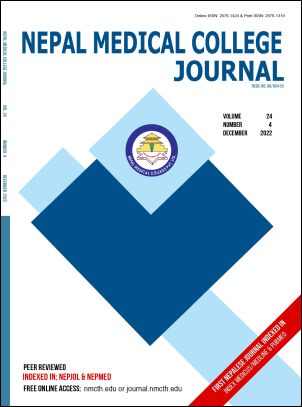Effect of Premenstrual Stress on Reaction Time among Medical and Dental Students of a Medical College in Kathmandu, Nepal
DOI:
https://doi.org/10.3126/nmcj.v24i4.50578Keywords:
Visual reaction time (VRT), premenstrual syndrome (PMS), premenstrual dysphoric disorder (PMDD), premenstrual stressAbstract
The cyclical variation of ovarian hormones during the menstrual cycle has been implicated as the causative factor for many psychological and physical symptoms referred as premenstrual syndrome (PMS) causing varying degree of stress in females. This study is aimed to find out whether premenstrual stress might cause any alteration in the visual reaction time (VRT) in pre-menstrual and post-menstrual phase. Reaction time is an efficient non-invasive tool to evaluate the sensorimotor efficacy of a person. A cross sectional observational study was carried out in consenting and regularly menstruating 86 undergraduate medical and dental students of age ranging from 18-22 years, for a study period of April 2022 to June 2022. PMS was screened by using the PSST (premenstrual symptoms screening tool) to evaluate the incidence of PMS and the degree of premenstrual stress among the participants. All the participants showed some degree of PMS with 53.4% showing mild and 46.5% showing moderate to severe symptoms while none showed premenstrual dysphoric disorder (PMDD). A significant difference in body weight and visual reaction time (P<0.0001) was observed between the premenstrual phase and postmenstrual phase (54.6 ± 7.23 kg Vs 54.2 ± 7.24 kg and 0.959 ± 0.271ms vs 0.811 ± 0.138ms, respectively) irrespective of the PMS degree. The results indicate that premenstrual stress do affect the sensorimotor efficacy in females having PMS.
Downloads
Downloads
Published
How to Cite
Issue
Section
License
Copyright (c) 2022 Nepal Medical College Journal

This work is licensed under a Creative Commons Attribution 4.0 International License.
This license enables reusers to distribute, remix, adapt, and build upon the material in any medium or format, so long as attribution is given to the creator. The license allows for commercial use.




